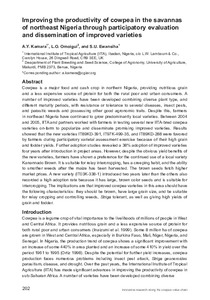| dc.contributor.author | Kamara, A.Y. |
| dc.contributor.author | Omoigui, L.O. |
| dc.contributor.author | Ewansiha, S.U. |
| dc.date.accessioned | 2019-12-04T11:08:01Z |
| dc.date.available | 2019-12-04T11:08:01Z |
| dc.date.issued | 2012 |
| dc.identifier.citation | Kamara, A.Y., Omoigui, L.O. & Ewansiha, S.U. (2012). Improving the productivity of cowpea in the savannas of northeast Nigeria through participatory evaluation and dissemination of improved varieties. In: Proceedings of the Fifth World Cowpea Conference on improving livelihoods in the cowpea value chain through advancement in science, held in Saly: Innovative research along the cowpea value chain, (pp. 202-211), 27 Sept. - 1 October, Ibadan, International Institute of Tropical Agriculture. |
| dc.identifier.isbn | 978-978-8444-07-7 |
| dc.identifier.uri | https://hdl.handle.net/20.500.12478/1692 |
| dc.description.abstract | Cowpea is a major food and cash crop in northern Nigeria, providing nutritious grain and a less expensive source of protein for both the rural poor and urban consumers. A number of improved varieties have been developed combining diverse plant type, and different maturity periods, with resistance or tolerance to several diseases, insect pests, and parasitic weeds and possessing other good agronomic traits. Despite this, farmers in northeast Nigeria have continued to grow predominantly local varieties. Between 2004 and 2005, IITA and partners worked with farmers in testing several new IITA-bred cowpea varieties on-farm to popularize and disseminate promising improved varieties. Results showed that the new varieties IT89KD-391, IT97K-499-35, and IT89KD-288 were favored by farmers during participatory varietal assessment exercise because of their high grain and fodder yields. Further adoption studies revealed a 38% adoption of improved varieties four years after introduction in project areas. However, despite the obvious yield benefits of the new varieties, farmers have shown a preference for the continued use of a local variety Kanannado Brown. It is suitable for relay intercropping, has a creeping habit, and the ability to smother weeds after the maize has been harvested. The brown seeds fetch higher market prices. A new variety (IT03K-338-1) introduced two years later than the others also recorded a high adoption rate because it has large, brown color seeds and is suitable for intercropping. The implications are that improved cowpea varieties in this area should have the following characteristics: they should be brown, have large grain size, and be suitable for relay cropping and controlling weeds, Striga tolerant, as well as giving high yields of grain and fodder. |
| dc.description.sponsorship | Canadian International Development Agency |
| dc.format.extent | 202-211 |
| dc.language.iso | en |
| dc.publisher | International Institute of Tropical Agriculture |
| dc.subject | Cowpeas |
| dc.subject | Crop Yield |
| dc.subject | Information Dissemination |
| dc.subject | Striga |
| dc.subject | Disease Control Methods |
| dc.subject | Grain Legumes |
| dc.subject | Livelihoods |
| dc.title | Improving the productivity of cowpea in the savannas of northeast Nigeria through participatory evaluation and dissemination of improved varieties |
| dc.type | Conference Proceedings |
| dc.description.version | Peer Review |
| cg.contributor.crp | Grain Legumes |
| cg.contributor.affiliation | International Institute of Tropical Agriculture |
| cg.contributor.affiliation | University of Agriculture, Makurdi |
| cg.coverage.region | Africa |
| cg.coverage.region | West Africa |
| cg.coverage.country | Nigeria |
| cg.authorship.types | CGIAR and developing country institute |
| cg.iitasubject | Cowpea |
| cg.iitasubject | Grain Legumes |
| cg.iitasubject | Knowledge Management |
| cg.iitasubject | Livelihoods |
| cg.howpublished | Formally Published |
| cg.publicationplace | Ibadan, Nigeria |
| cg.accessibilitystatus | Limited Access |
| local.dspaceid | 82916 |
| cg.targetaudience | Scientists |


